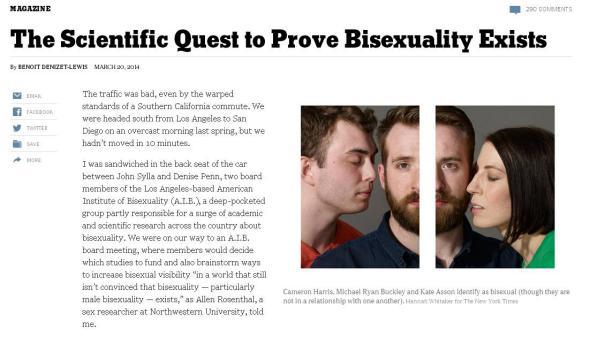On Thursday, the New York Times Magazine released Benoit Denizet-Lewis’ lengthy exploration of the bisexual movement, for which the author, among other feats of journalistic rigor, wore a “penile-strain gauge” while watching porn in a vinyl armchair at a Northwestern laboratory. The article is funny and fascinating, an incisive dismantlement of myriad pernicious myths about bisexuality. But strangely, Denizet-Lewis fails to address the niggling question at the heart of the modern bisexual movement: What does bisexuality, as an identity, actually mean?
In a very basic sense, of course, the definition of bisexuality is obvious: The desire to have sex with both men and women. But scratch at that rudimentary surface and you’ll find a tangle of contradictions. Start with the stereotypes: Bi men are often perceived to be gay men with forays into heterosexuality—yet bi women are frequently painted as straight women with forays into homosexuality. According to general cultural wisdom, then, the bi male baseline starts at gay, while the bi female baseline starts at straight. And no matter how close bi people move toward a Kinsey 3, society will never allow them to completely shake their purported starting point.
Those are only the clichés, of course; within the bisexual movement, the antinomies grow far sharper. Is bisexuality the ability “to fall in love with people regardless of their gender,” as Denizet-Lewis’ bisexual friend states? Or is it, as others insist, the ability to fall in love with both men and women in part because of their genders? Each of these stances is really quite distinct; the former ignores (or transcends) gender, while the latter embraces both genders equally. Yet both of them wind up shoehorned into the umbrella category of “bisexuality.”
Of course, all this questioning is in some ways a political trap—the end-goal of the LGBTQ movement as a whole could be described as a world in which the interrogation of individual (consenting adult) desires is no longer a cultural pastime. That said, as a thought experiment, it’s interesting to consider the black hole at the center of Denizet-Lewis’ piece: Is bisexuality even an identity, in the way that homosexuality is?
The bisexual movement understandably wants us to believe it is, which makes sense; after all, the gay rights movement only found success by painting homosexuality as something you are, not something you do. But isn’t bisexuality, by any of the above definitions, very much something you simply do? Several of Denizet-Lewis’ interviewees seem to suggest so; when musing about their sexual experiences, never does any of them claim that their bisexuality meant anything more than the sum total of their romantic and erotic desire for men and women.
If you believe, I suppose, that homosexuality means nothing more than same-sex desire, then none of that should matter. But if you believe that being gay is an identity, that there is such a thing as gay culture and a shared gay experience beyond the parameters of sex, then these are questions of tantamount importance. Not one of Denizet-Lewis’ interviewees ever says that there’s more to the bisexual identity than its bare, sexual core. That paucity could be a product of the types of questions Denizet-Lewis asked, or it could be that his informants don’t cotton to the idea of bi-as-worldview presented by theorists like Shiri Eisner. But either way, the bisexual community depicted in this story exists primarily to further the visibility of bisexuals.
That’s not to say that a true bisexual culture couldn’t flourish in world with more bi openness. It simply means that, given the current ubiquity of bisexual erasure, it’s nearly impossible to imagine a developed bisexual culture at this point in time. Try, for instance, to contemplate a genre of bisexual film or literature, or a mode of bisexual criticism. A book that’s identifiably “gay” has signifiers beyond sexual desires; most identifiably “bisexual” books merely have bisexual characters. That could surely change—but not until the bisexual movement focuses on more than just proving its own existence.
If you dwell too long on the interviews in Denizet-Lewis’ story, you might come away from it feeling that bisexuality, as an identity, is little more than a useful fiction. Don’t believe it. The problem lies not in bisexuality itself, but in the modern bisexual movement, which has failed to articulate a coherent platform beyond its initial goals of recognition. If bi activists continue to define bisexuality as nothing more than a more imaginative set of erotic and romantic urges, they’ll further forestall the development of a mature bi culture—giving us no more than the completely sex-oriented definition we started out with. Bi people deserve better than that. It’s time for their movement to stop substantiating its own existence and start trying to give that existence the cultural substance it craves.
